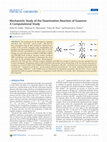Papers by Raymond Poirier
Chemical Physics Letters, Aug 1, 1987
The second-order connected moments expansion (CMX(2)) approach to calculation of the correlation ... more The second-order connected moments expansion (CMX(2)) approach to calculation of the correlation energy is tested numerically on several closed-shell di- and tri-atomic molecules. Benchmark computations performed within 6-31G ** basis set reveal that CMX(2) usually recovers more than 50% of the MP3 correlation energy and improves the SCF molecular geometries at a cost comparable to the MP3 calculations.
Journal of the American Chemical Society, 1986
... Acknowledgment. We thank Dr. M. Zoda for his early ex-ploratory experiments and Dr. M. Durais... more ... Acknowledgment. We thank Dr. M. Zoda for his early ex-ploratory experiments and Dr. M. Duraisamy for many helpful discussions. ... A Molecular Orbital Evaluation of Conformational Effects in Promoting Reactivity Gregory R. J. Thatcher, Raymond Poirier,+ and Ronald Kluger* ...

The Journal of Physical Chemistry a, Feb 1, 2011
The mechanism for the deamination of guanine with H 2 O, OH -, H 2 O/OHand for GuaH þ with H 2 O ... more The mechanism for the deamination of guanine with H 2 O, OH -, H 2 O/OHand for GuaH þ with H 2 O has been investigated using ab initio calculations. Optimized geometries of the reactants, transition states, intermediates, and products were determined at RHF/6-31G(d), MP2/6-31G(d), B3LYP/6-31G(d), and B3LYP/6-31þG(d) levels of theory. Energies were also determined at G3MP2, G3MP2B3, G4MP2, and CBS-QB3 levels of theory. Intrinsic reaction coordinate (IRC) calculations were performed to characterize the transition states on the potential energy surface. Thermodynamic properties (ΔE, ΔH, and ΔG), activation energies, enthalpies, and Gibbs free energies of activation were also calculated for each reaction investigated. All pathways yield an initial tetrahedral intermediate and an intermediate in the last step that dissociates to products via a 1,3-proton shift. At the G3MP2 level of theory, deamination with OHwas found to have an activation energy barrier of 155 kJ mol -1 compared to 187 kJ mol -1 for the reaction with H 2 O and 243 kJ mol -1 for GuaH þ with H 2 O. The lowest overall activation energy, 144 kJ mol -1 at the G3MP2 level, was obtained for the deamination of guanine with H 2 O/OH -. Due to a lack of experimental results for guanine deamination, a comparison is made with those of cytosine, whose deamination reaction parallels that of guanine. 2066 dx.
Chemical Physics Letters, 1990
Chemical Physics Letters, 1986
As preliminary numerical examples, we report some calculations on intermolecular interactions usi... more As preliminary numerical examples, we report some calculations on intermolecular interactions using a new method of perturbation theory introduced recently. The He…He, LiH…LiH and water—water interactions are studied with small basis sets. The essential feature of the method is that it eliminates basis set superposition errors without any a posteriori collection. Within the range of applicability of the perturbational treatment, the results may be superior to standard vibrational calculations which suffer from large basis set superposition errors.
Cheminform, 2010
Ab initio Study on the Thermal Decarboxylation of But-3-enoic Acid and Its Derivatives.
Journal of Molecular Structure Theochem, 1981
Non-empirical SCF MO calculations have been carried out on the Br' + ethylene electrophilic addit... more Non-empirical SCF MO calculations have been carried out on the Br' + ethylene electrophilic addition process for the first time. Geometry optimizations were performed with a standard STO-3G basis set, except for bromine.
Can J Chem, 1975
... 'KT Leffek, private communication. Can. J. Chem. Downloaded from www. nrcresearchpress.c... more ... 'KT Leffek, private communication. Can. J. Chem. Downloaded from www. nrcresearchpress.com by 66.249.68.24 on 05/11/11 For personal use only. Page 2. WESTAWAY AND POIRIER: N1 JCLEOPHILIC SUBSTITUTION. I 3217 ...

Can J Chem, 1991
ABSTRACT Ab initio calculations are performed to investigate the effect of water on the 1,3-intra... more ABSTRACT Ab initio calculations are performed to investigate the effect of water on the 1,3-intramolecular hydrogen rearrangement in the isoelectronic series, for X, Y = CH2, NH or O, by modeling with a single H2O molecule. The geometries for the complexes are optimized at both the 3-21G and 6-31G** basis set levels. MP2 and some MP4 calculations are performed to take into account the correlation effects, and ZPV corrections are calculated at the MNDO level. The results show that the water molecule has a significant effect on the molecules in which hydrogen bonds can be formed or partially formed. The "solvent effects" are also examined using the self-consistent reaction-field (SCRF) approach. A combination of supermolecule and SCRF approach appears to work well at predicting the effect of solvent on relative stabilities and barriers. Key words: tautomerism, ab initio, 1,3-hydrogen rearrangement, solvent effects.
International Journal of Quantum Chemistry
ABSTRACT
Journal of Molecular Structure
Interconversion of the three isomeric or valence tautomeric structures of C,H,Br+
Journal of Photochemistry
ABSTRACT

Journal of Molecular Structure: THEOCHEM, 1985
interaction of 1,5 type, have been studied by the ab initio SCF-MO method. The critical points of... more interaction of 1,5 type, have been studied by the ab initio SCF-MO method. The critical points of the relaxed conformational potential energy surface have been obtained with STO-3G optimized geometries and compared to those of a rigid surface. The antiperiplanar-synperiplanar (ap-sp) conformation with S l l -0 close contact is found to be the most favourable. As calculated by STO-BG, STO-3G* and 6-31G* basis sets, the preferred ap-sp and ap-ap conformations differ in energy by 1.2, 3.8 and 6.5 kcal mol-, respectively. In accordance with known experimental rules about sulfm-oxygen interaction, the calculated F-S ---0 angle (169.6") is nearly linear. The S* l -0 nonbonded distance (2.852 A), as in most @-enone structures, is not extremely short. Bond lengths and bond angles do not differ significantly in the minimum energy conformations with or without S* l -0 close contact. In the case of (Z)-3-fluorothio-2-propenal the sulfur-oxygen interaction can be rationalized qualitatively by eleetrostatic effects of dipolar character between F-S and O=C moieties. been known to control the actual conformation of a number of organosulfur compounds [ 11. Up to the end of 1982 about 400 crystalline compounds were registered which exhibit S. * l 0 close contact significantly shorter (2.03-3.00 A) than the sum of the corresponding van der Waals radii (3.25 A). An electron diffraction study of 2-nitrobenzenesulfenyl chloride has shown recently [2] that attractive effects between nonbonded sulfur and oxygen aDedicated to Professor Raymond Daudel on the occasion of his 65th birthday. *Permanent address: Chinoin Pharmaceutical and Chemical Works, H-1325 Budapest, P.O.B. 110, Hungary. 0166-1280/85/$03.30 0 1985 Elsevier Science Publishers B.V.
Journal of the American Chemical Society
Through the use of a potentially removable tether, a heavily substituted 10b,10c-dimethyl-10b,10c... more Through the use of a potentially removable tether, a heavily substituted 10b,10c-dimethyl-10b,10c-dihydropyrene (DMDHP), 20, was synthesized exclusively as the cis-isomer. It exists as the major component (20:1) in an equilibrium with its valence isomer syn-[2.2]metacyclophanediene 19. An X-ray crystal structure determination of 20, a cis-(2,7)-10b,10c-dihydropyrenophane, provided the first experimental measurements of the cis-DMDHP skeleton. The observed bond alternation in the [14]annulene was found to be larger than that of the corresponding trans-DMDHP framework. Prior MMPI calculations, on which previous discussion of the structure of the cis-DMDHP system had been based, are in very good agreement with the experimental results. Our own DFT calculations predict a more symmetric and more bond equalized structure than was observed in 20.
Journal of Molecular Structure: THEOCHEM, 1995
ABSTRACT

Journal of Molecular Structure: THEOCHEM, 1989
For the twelve title species, the bond order accordingto Mayer's definition, the Mulliken overlap... more For the twelve title species, the bond order accordingto Mayer's definition, the Mulliken overlap population and the force constants are determined using the minimal STO-3G, split-valence 3-21G and 6-31G* (5d) basis sets. In general all these properties increase with increasing formal charge for each diatomic species. In contrast, the internuclear distances decrease with increasing formal charge. These findings indicate that the outer electrons in the three neutral diatomic species reside in antibonding orbitals; removing them results in triple bonds in the dications which are all predicted to be stable in their ground states in spite of the electrostatic repulsion. The best predictions for the unknown internuclear distances in the ionic ground states p r, ( 0z2+ ) = 1.046; r,(SO'+)=1.411; r,(SO'+)=1.359; r,(S,'+)=1.800and r,.Sz2+)=1.732 A. Foracetylene, the behaviour on removal of the electrons is opposite to that observed for the diatomics: the bond order, overlap population and force constants all decrease with increasing formal charge. Both the acetylenic cation and dication are predicted to be @able, linear species in their electronic ground states with r,(C-S) =1.247 and r,(C-H) =1.076 A for the monocation and r,(C-C) =1.326 and r, (C-H) = 1.116 A for the triplet dication. Using the SCF optimized structures, the total energies for the species were computed at the CISD and CISD-Q levels. These lead to predicted second ionization potentials of about 24.









Uploads
Papers by Raymond Poirier